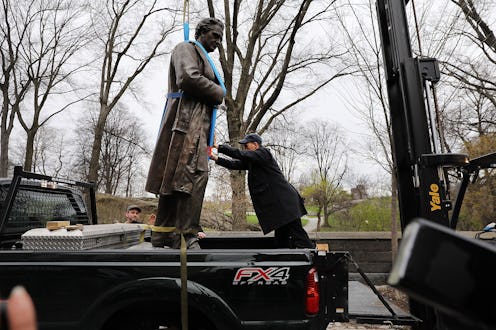Life
An Inflammatory NYC Statue Is Being Moved — But Activists Want It Taken Down Entirely

The city of New York removed a statue of surgeon J. Marion Sims from its Central Park location today, after a push from activists. Sims, who died in 1883, is often called the "father of modern gynecology" for his research on women's health — he invented both the speculum and a surgery to treat vaginal fistulas. But he reached his conclusions by experimenting on enslaved Black women without anesthesia or informed consent, a fact that has come to light in recent years. The city isn't getting rid of the monument entirely, though — the New York Times reports that the statue will be moved to the cemetery where Sims is buried — and activists aren't happy about it.
According to HISTORY, Sims didn't use anesthesia or any numbing during his procedures because of a misguided belief that Black women weren't as sensitive to pain as white women — a reminder that racist stereotypes can literally be deadly. "While some may have thought Dr. J. Marion Sims was a pioneer, we know that his work was highly unethical and deeply racist," says New York City Public Advocate Letitia James in a statement shared on Twitter. "A monument to recognize a serial torturer of enslaved black women has no place in our city & today action is being taken to finally remove it."
Calls to remove the statue increased in 2017 after protests surrounding the continued existence of Confederate monuments intensified around the country, and city mayor Bill de Blasio announced in January that the Sims statue would be relocated. The new monument site, the mayor said, would also include informational plaques and new artwork to "inform the public of the origin of the statue and historical context, including the legacy of non-consensual medical experimentation on women of color broadly and Black women specifically that Sims has come to symbolize."
New York-based advocacy organization East Harlem Preservation has long campaigned for the statue's removal, and they shared a statement expressing dissatisfaction with the decision to relocate the statute. "Dr. Sims is not our hero, and we don’t need any reminders of his barbarities. We bear the pain and burden of intergenerational trauma every day," the organization wrote. "The symbolic 'move' was seen as a slap in the face by many who had for years maintained that the statue’s presence did a huge disservice to the neighborhood’s majority Black and Latino residents—groups that have historically been subjected to medical experiments without permission or regard for their wellbeing."
According to HISTORY, Sims acknowledged in his notes that the Black women he treated sometimes seemed to be in agony. In one example, he performed 30 surgeries on a 17-year-old slave over a four-year period. Still, the monument reads, "Surgeon and philanthropist [...] his brilliant achievement carried the fame of American surgery throughout the entire world." A placard also notes that it was erected "in recognition of his services in the cause of science and mankind." Though Sims's experiments led to legitimately useful medical findings that are still in use today, the physical and emotional trauma experienced by the enslaved women he experimented on outweigh any possible gains — it should be noted that, as HISTORY reports, slaveowners usually sought treatment from Sims once slaves began to have trouble reproducing.
It's possible to recognize the historical impact of Sims's findings without (literally) elevating him to a position of admiration. East Harlem Preservation recommends lauding doctors and researchers of color who have conducted research that have helped oppressed people instead. It's unclear whether the city will respond to calls to remove the statue completely, but recognizing the trauma that Sims effected is a much-needed start.